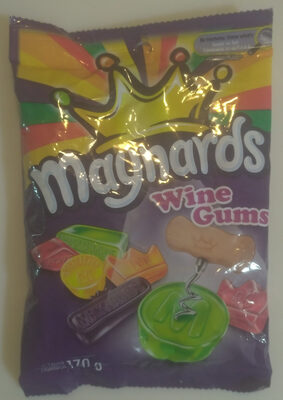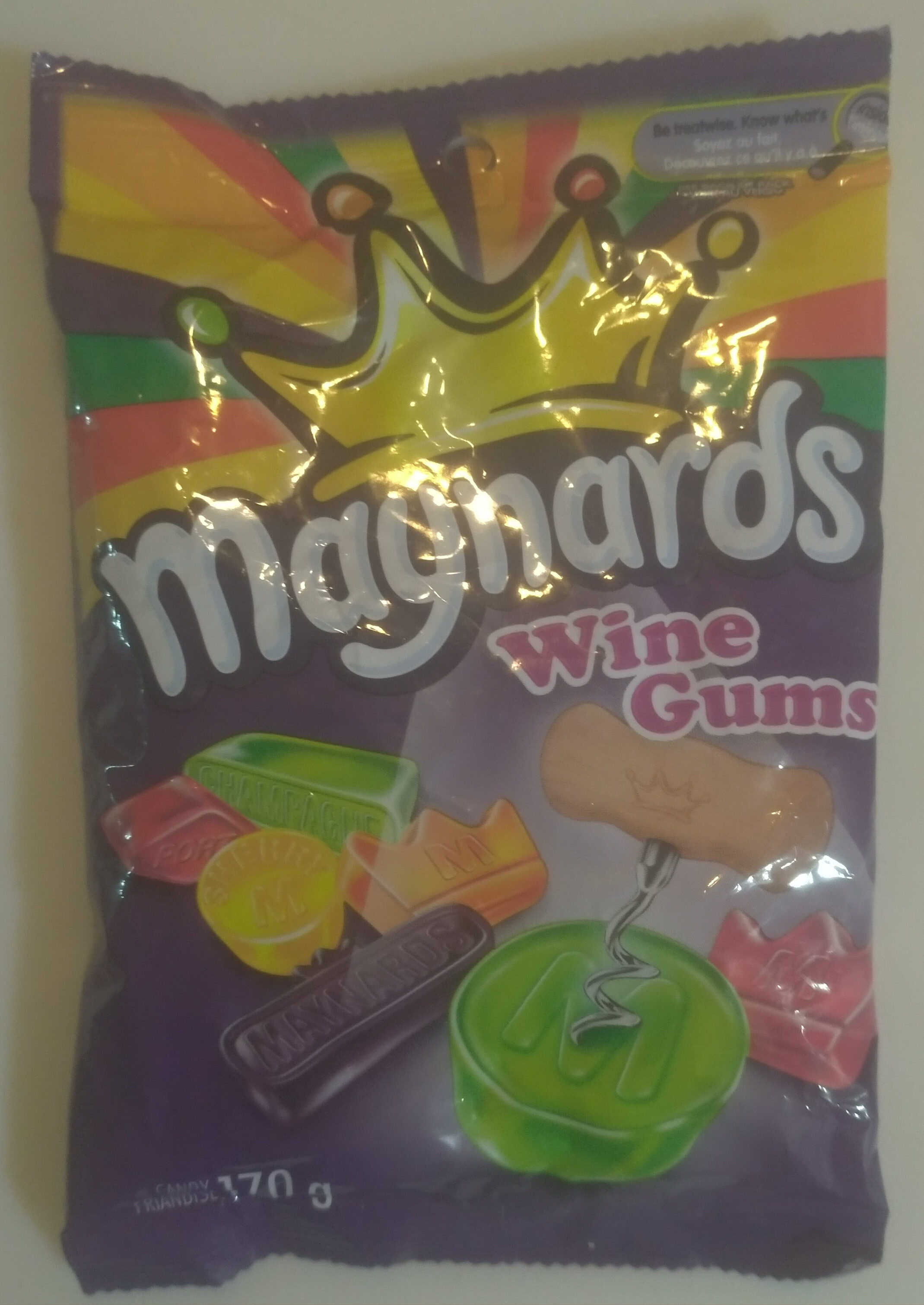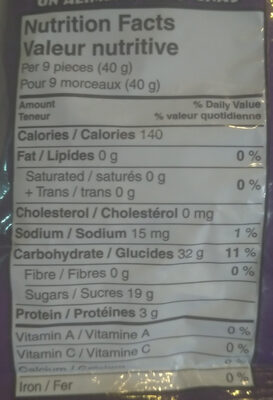Aidez-nous à faire de la transparence alimentaire la norme !
En tant qu'organisation à but non lucratif, nous dépendons de vos dons pour continuer à informer les consommateurs du monde entier sur ce qu'ils mangent.
La révolution alimentaire commence avec vous !
Wine Gums - Maynards - 170 g
Wine Gums - Maynards - 170 g
La page de ce produit n'est pas complète. Vous pouvez aider à la compléter en l'éditant et en ajoutant plus de données à partir des photos que nous avons, ou en prenant plus de photos à l'aide de l'application pour Android ou iPhone / iPad. Merci!
×
Code-barres: 0057700215012 (EAN / EAN-13) 057700215012 (UPC / UPC-A)
Quantité : 170 g
Marques : Maynards
Catégories : Snacks, Snacks sucrés, Confiseries, Bonbons
Lien vers la page du produit sur le site officiel du fabricant : https://www.snackworks.ca/en/Products/Pr...
Magasins : Walmart, Safeway, Shopper's Drug Mart
Pays de vente : Canada
Correspondance avec vos préférences
Santé
Ingrédients
-
10 ingrédients
Anglais : Glucose syrup, Sugar, Modified corn starch, Gelatin, Acetic acid, Carnauba wax, Mineral oil, Natural and artificial flavours, Colour (Tartrazine)Allergènes : en:Gelatin
Transformation des aliments
-
Aliments ultra-transformés
Éléments qui indiquent que le produit est dans le groupe 4 - Produits alimentaires et boissons ultra-transformés :
- Additif : E102 - Tartrazine
- Additif : E428 - Gélatine
- Additif : E903 - Cire de carnauba
- Additif : E905 - Cire synthétique
- Ingrédient : Colorant
- Ingrédient : Arôme
- Ingrédient : Glucose
- Ingrédient : Sirop de glucose
Les produits alimentaires sont classés en 4 groupes selon leur degré de transformation :
- Aliments non transformés ou minimalement transformés
- Ingrédients culinaires transformés
- Aliments transformés
- Aliments ultra-transformés
La détermination du groupe est basée sur la catégorie du produit et sur les ingrédients qu'il contient.
Additifs
-
E102 - Tartrazine
Tartrazine : La tartrazine est un colorant azoïque jaune -E102- de synthèse.Source : Wikipedia
-
E260 - Acide acétique
Acide acétique : L'acide acétique ou acide éthanoïque est un acide carboxylique avec une chaîne carbonée théorique en C2, analogue à l'éthane, de masse molaire 60 g/mol et de formule chimique brute C2H4O2 ou semi-développée CH3-CO-OH. L'adjectif du nom courant provient du latin acetum, signifiant vinaigre. En effet, l'acide acétique représente le principal constituant du vinaigre après l'eau, puisqu'il lui donne son goût acide et son odeur piquante détectable à partir de 1 ppm. La distillation du vinaigre, attestée dès l'époque médiévale en Europe, a permis d'obtenir l'acide acétique pur, liquide combustible incolore à forte odeur de vinaigre, de masse volumique de l'ordre de 1‚05 g·cm-3 à 20 °C qui se solidifie par simple immersion dans un bain eau-glace. Il est encore connu sous le nom d'acide acétique glacial ou autrefois de vinaigre fort. C'est le premier acide industriel connu. Ce liquide très faiblement conducteur, incolore, inflammable et hygroscopique représente à température ambiante un des plus simples acides monocarboxyliques, avec l'acide formique. Son acidité caractérisée en solution aqueuse par un pKa = 4‚76 vient de sa capacité à perdre temporairement le proton de sa fonction carboxylique, le transformant ainsi en ion acétate CH3COO-. C'est un acide faible. L'acide éthanoïque est un antiseptique et un désinfectant[réf. insuffisante]. Il est corrosif et ses vapeurs sont irritantes pour le nez et les yeux. Très corrosif vis-à-vis des tissus organiques et vivants, il doit être manipulé avec soin. Bien qu'il n'ait pas été jugé cancérigène ou dangereux pour l'environnement, il peut causer des brûlures ainsi que des dommages permanents à la bouche, au nez, à la gorge et aux poumons. À certaines doses et en co-exposition chronique avec un produit cancérigène, son caractère irritant en fait un promoteur tumoral de tumeurs -bénignes et malignes-. Ceci a été démontré expérimentalement chez le rat. Dans le corps humain, l'acide acétique est normalement produit après la consommation d'alcool : l'éthanol est converti en acétaldéhyde qui est alors converti en acide acétique sous l'influence de l'enzyme acétaldéhyde déshydrogénase et ensuite en acetyl-coA par la ligase acétate-CoA.Source : Wikipedia
-
E903 - Cire de carnauba
Cire de carnauba : La carnaúba est une cire issue des feuilles d'un palmier du nord-est du Brésil, le Copernicia prunifera. Elle se trouve généralement sous la forme de copeaux jaunes-bruns, cassants, très odorants. Cette cire est obtenue par le battage des feuilles de Copernicia prunifera, suivi d'un raffinage et parfois d'un blanchiment.Source : Wikipedia
-
E905 - Cire synthétique
Microcrystalline wax : Microcrystalline waxes are a type of wax produced by de-oiling petrolatum, as part of the petroleum refining process. In contrast to the more familiar paraffin wax which contains mostly unbranched alkanes, microcrystalline wax contains a higher percentage of isoparaffinic -branched- hydrocarbons and naphthenic hydrocarbons. It is characterized by the fineness of its crystals in contrast to the larger crystal of paraffin wax. It consists of high molecular weight saturated aliphatic hydrocarbons. It is generally darker, more viscous, denser, tackier and more elastic than paraffin waxes, and has a higher molecular weight and melting point. The elastic and adhesive characteristics of microcrystalline waxes are related to the non-straight chain components which they contain. Typical microcrystalline wax crystal structure is small and thin, making them more flexible than paraffin wax. It is commonly used in cosmetic formulations. Microcrystalline waxes when produced by wax refiners are typically produced to meet a number of ASTM specifications. These include congeal point -ASTM D938-, needle penetration -D1321-, color -ASTM D6045-, and viscosity -ASTM D445-. Microcrystalline waxes can generally be put into two categories: "laminating" grades and "hardening" grades. The laminating grades typically have a melt point of 140-175 F -60 - 80 oC- and needle penetration of 25 or above. The hardening grades will range from about 175-200 F -80 - 93 oC-, and have a needle penetration of 25 or below. Color in both grades can range from brown to white, depending on the degree of processing done at the refinery level. Microcrystalline waxes are derived from the refining of the heavy distillates from lubricant oil production. This by-product must then be de-oiled at a wax refinery. Depending on the end use and desired specification, the product may then have its odor removed and color removed -which typically starts as a brown or dark yellow-. This is usually done by means of a filtration method or by hydro-treating the wax material.Source : Wikipedia (Anglais)
-
E905a - Huile minérale de qualité alimentaire
Microcrystalline wax : Microcrystalline waxes are a type of wax produced by de-oiling petrolatum, as part of the petroleum refining process. In contrast to the more familiar paraffin wax which contains mostly unbranched alkanes, microcrystalline wax contains a higher percentage of isoparaffinic -branched- hydrocarbons and naphthenic hydrocarbons. It is characterized by the fineness of its crystals in contrast to the larger crystal of paraffin wax. It consists of high molecular weight saturated aliphatic hydrocarbons. It is generally darker, more viscous, denser, tackier and more elastic than paraffin waxes, and has a higher molecular weight and melting point. The elastic and adhesive characteristics of microcrystalline waxes are related to the non-straight chain components which they contain. Typical microcrystalline wax crystal structure is small and thin, making them more flexible than paraffin wax. It is commonly used in cosmetic formulations. Microcrystalline waxes when produced by wax refiners are typically produced to meet a number of ASTM specifications. These include congeal point -ASTM D938-, needle penetration -D1321-, color -ASTM D6045-, and viscosity -ASTM D445-. Microcrystalline waxes can generally be put into two categories: "laminating" grades and "hardening" grades. The laminating grades typically have a melt point of 140-175 F -60 - 80 oC- and needle penetration of 25 or above. The hardening grades will range from about 175-200 F -80 - 93 oC-, and have a needle penetration of 25 or below. Color in both grades can range from brown to white, depending on the degree of processing done at the refinery level. Microcrystalline waxes are derived from the refining of the heavy distillates from lubricant oil production. This by-product must then be de-oiled at a wax refinery. Depending on the end use and desired specification, the product may then have its odor removed and color removed -which typically starts as a brown or dark yellow-. This is usually done by means of a filtration method or by hydro-treating the wax material.Source : Wikipedia (Anglais)
Analyse des ingrédients
-
Sans huile de palme
Aucun ingrédient contenant de l'huile de palme détecté
-
Non végétalien
Ingrédients non végétaliens : E428
-
Non végétarien
Ingrédients non végétariens : E428
-
Détail de l'analyse des ingrédients
en: Glucose syrup, Sugar, Modified corn starch, Gelatin, Acetic acid, Carnauba wax, Mineral oil, Natural and artificial flavours, Colour (Tartrazine)- Glucose syrup -> en:glucose-syrup - vegan: yes - vegetarian: yes - ciqual_proxy_food_code: 31016 - percent_min: 11.1111111111111 - percent_max: 100
- Sugar -> en:sugar - vegan: yes - vegetarian: yes - ciqual_proxy_food_code: 31016 - percent_min: 0 - percent_max: 47.5
- Modified corn starch -> en:modified-corn-starch - vegan: yes - vegetarian: yes - ciqual_food_code: 9510 - percent_min: 0 - percent_max: 33.3333333333333
- Gelatin -> en:e428 - vegan: no - vegetarian: no - percent_min: 0 - percent_max: 25
- Acetic acid -> en:e260 - vegan: yes - vegetarian: yes - percent_min: 0 - percent_max: 20
- Carnauba wax -> en:e903 - vegan: yes - vegetarian: yes - percent_min: 0 - percent_max: 16.6666666666667
- Mineral oil -> en:e905a - vegan: yes - vegetarian: yes - percent_min: 0 - percent_max: 14.2857142857143
- Natural and artificial flavours -> en:natural-and-artificial-flavouring - vegan: maybe - vegetarian: maybe - percent_min: 0 - percent_max: 5
- Colour -> en:colour - percent_min: 0 - percent_max: 5
- Tartrazine -> en:e102 - vegan: yes - vegetarian: yes - percent_min: 0 - percent_max: 5
Nutrition
-
Mauvaise qualité nutritionnelle
⚠ ️Avertissement : Le taux de fruits, légumes et noix n'est pas indiqué sur l'étiquette, il a été estimé en fonction de la liste des ingrédients : 0Ce produit n'est pas considéré comme une boisson pour le calcul du Nutri-Score.
Points positifs : 0
- Protéines : 4 / 5 (valeur : 7.5, valeur arrondie : 7.5)
- Fibre : 0 / 5 (valeur : 0, valeur arrondie : 0)
- Fruits, légumes, noix et huiles de colza / noix / olive : 0 / 5 (valeur : 0, valeur arrondie : 0)
Points négatifs : 14
- Énergie : 4 / 10 (valeur : 1460, valeur arrondie : 1460)
- Sucres : 10 / 10 (valeur : 47.5, valeur arrondie : 47.5)
- Graisses saturées : 0 / 10 (valeur : 0, valeur arrondie : 0)
- Sodium : 0 / 10 (valeur : 37.5, valeur arrondie : 37.5)
Les points pour les protéines ne sont pas comptés car les points négatifs sont supérieurs ou égaux à 11.
Score nutritionnel : (14 - 0)
Nutri-Score :
-
Repères nutritionnels
-
Matières grasses en faible quantité (0%)
Ce que vous devez savoir- Une consommation élevée de graisses, en particulier de graisses saturées, peut augmenter le cholestérol, ce qui augmente le risque de maladies cardiaques.
Recommandation : Réduire la consommation de graisses et de graisses saturées- Choisissez des produits à faible teneur en graisses et en graisses saturées.
-
Acides gras saturés en faible quantité (0%)
Ce que vous devez savoir- Une consommation élevée de graisses, en particulier de graisses saturées, peut augmenter le cholestérol, ce qui augmente le risque de maladies cardiaques.
Recommandation : Réduire la consommation de graisses et de graisses saturées- Choisissez des produits à faible teneur en graisses et en graisses saturées.
-
Sucres en quantité élevée (47.5%)
Ce que vous devez savoir- Une forte consommation de sucre peut entraîner une prise de poids et des caries dentaires. Il augmente également le risque de diabète de type 2 et de maladies cardio-vasculaires.
Recommandation : Limiter la consommation de sucre et de boissons sucrées- Les boissons sucrées (comme les sodas, les boissons aux fruits, les jus et nectars de fruits) doivent être limitées au maximum (pas plus d'un verre par jour).
- Choisissez des produits à faible teneur en sucre et réduisez la consommation de produits avec des sucres ajoutés.
-
Sel en faible quantité (0.0938%)
Ce que vous devez savoir- Une forte consommation de sel (ou de sodium) peut entraîner une augmentation de la pression artérielle, ce qui peut augmenter le risque de maladie cardiaque et d'accident vasculaire cérébral.
- De nombreuses personnes souffrant d'hypertension ne le savent pas, car il n'y a souvent aucun symptôme.
- La plupart des gens consomment trop de sel (en moyenne 9 à 12 grammes par jour), soit environ le double de l'apport maximal recommandé.
Recommandation : Limiter la consommation de sel et d'aliments salés- Réduisez la quantité de sel utilisée lors de la cuisson et ne salez plus à table.
- Limitez la consommation de collations salées et choisissez des produits à faible teneur en sel.
-
-
Tableau nutritionnel
Tableau nutritionnel Tel que vendu
pour 100 g / 100 mlTel que vendu
par portion (40 g)Comparé à: Bonbons Énergie 1 460 kj
(350 kcal)586 kj
(140 kcal)-1 % Matières grasses 0 g 0 g -100 % Acides gras saturés 0 g 0 g -100 % Acides gras trans 0 g 0 g Cholestérol 0 mg 0 mg Glucides 80 g 32 g -3 % Fibres alimentaires 0 g 0 g -100 % Sucres 47,5 g 19 g -17 % Protéines 7,5 g 3 g +232 % Sel 0,094 g 0,038 g -18 % Vitamine A (rétinol) 0 µg 0 µg (0 % DV) Vitamine C (acide ascorbique) 0 mg 0 mg (0 % DV) Calcium 0 mg 0 mg (0 % DV) -100 % Fer 0 mg 0 mg (0 % DV) -100 % Fruits‚ légumes‚ noix et huiles de colza‚ noix et olive (estimation par analyse de la liste des ingrédients) 0 % 0 %
Environnement
-
Eco-Score C - Impact modéré sur l'environnement
⚠ ️L'impact total du transport sur votre pays est actuellement inconnu.L'Eco-Score est un score expérimental qui synthétise les impacts environnementaux des produits alimentaires.→ L'Eco-Score a été initialement conçu pour la France et est en cours d'extension à d'autres pays européens. La formule de l'Eco-Score est susceptible d'évoluer car elle est régulièrement améliorée pour la rendre plus précise et mieux adaptée à chaque pays.Analyse du cycle de vie
-
Impact moyen des produits de la même catégorie : B (Score: 62/100)
Catégorie : Bonbons, tout type
Catégorie : Bonbons, tout type
- Score environnemental PEF : 0.41 (plus le score est bas, plus l'impact est faible)
- dont impact sur le changement climatique : 1.73 kg CO2 eq/kg de produit
Etape Impact Agriculture
78.2 %Transformation
10.7 %Emballage
5.5 %Transport
4.5 %Distribution
1.1 %Consommation
0.0 %
Bonus et malus
-
Informations manquantes sur les origines des ingrédients
Malus :
⚠ ️ Les origines des ingrédients de ce produit ne sont pas renseignées.
Si elles sont indiquées sur l'emballage, vous pouvez modifier la fiche produit et les ajouter.
Si vous êtes le fabricant de ce produit, vous pouvez nous transmettre les informations avec notre plateforme gratuite pour les producteurs.
-
Informations d'emballage manquantes pour ce produit
Malus : -15
⚠ ️ Les informations sur l'emballage de ce produit ne sont pas renseignées.⚠ ️ Pour un calcul plus précis de l'Eco-Score, vous pouvez modifier la fiche produit et les ajouter.
Si vous êtes le fabricant de ce produit, vous pouvez nous transmettre les informations avec notre plateforme gratuite pour les producteurs.
Eco-Score pour ce produit
-
Impact pour ce produit: C (Score: 42/100)
Produit : Wine Gums - Maynards - 170 g
Score d'analyse du cycle de vie : 62
Somme des bonus et malus : -15
Score final : 42/100
-
Empreinte carbone
-
Équivaut à parcourir 0.9 km dans une voiture à essence
173 g de CO² pour 100g de produit
Le chiffre d'émission carbone est issu de la base de données Agribalyse de l'ADEME, pour la catégorie : Bonbons, tout type (Source : Base de données ADEME Agribalyse)
Etape Impact Agriculture
52.3 %Transformation
19.5 %Emballage
15.7 %Transport
11.6 %Distribution
1.0 %Consommation
0.0 %
Emballage
-
Informations d'emballage manquantes pour ce produit
⚠ ️ Les informations sur l'emballage de ce produit ne sont pas renseignées.Prendre une photo des informations de recyclage Prendre une photo des informations de recyclage
Transport
-
Origines des ingrédients
Informations manquantes sur les origines des ingrédients
⚠ ️ Les origines des ingrédients de ce produit ne sont pas renseignées.
Si elles sont indiquées sur l'emballage, vous pouvez modifier la fiche produit et les ajouter.
Si vous êtes le fabricant de ce produit, vous pouvez nous transmettre les informations avec notre plateforme gratuite pour les producteurs.Ajouter les origines des ingrédients pour ce produit Ajouter les origines des ingrédients pour ce produit
Signaler un problème
-
Informations incomplètes ou incorrectes ?
Catégorie, labels, ingrédients, allergènes, informations nutritionnelles, photos etc.
Si les informations ne correspondent pas aux informations présentes sur l'emballage, vous pouvez les compléter ou de les corriger. Merci ! Open Food Facts est une base de données collaborative, et chaque contribution est utile à tous.
Sources de données
Produit ajouté le par halal-app-chakib
Dernière modification de la page produit le par binzyboi.
Fiche produit également modifiée par inf, kiliweb, openfoodfacts-contributors, yuka.Fqx6IsCiLcp6Ndz739gozRyBJr_xHKdeHnQjog.










